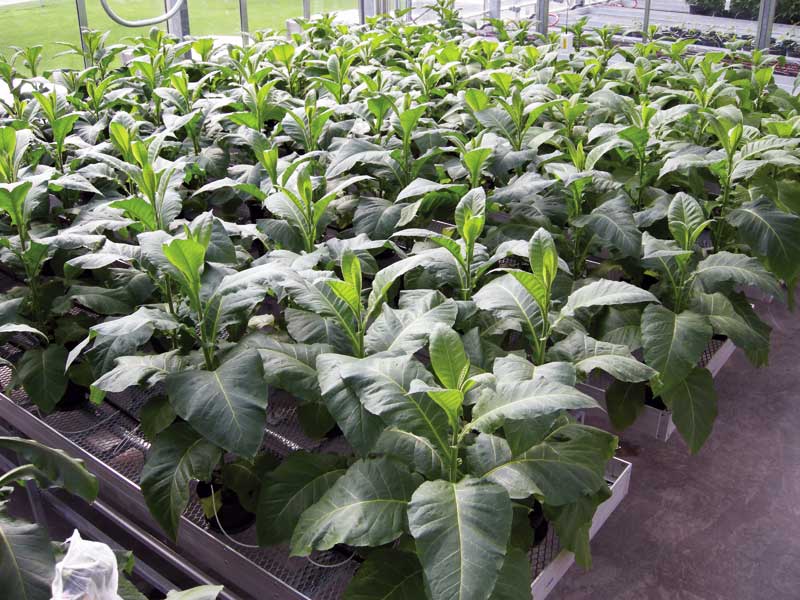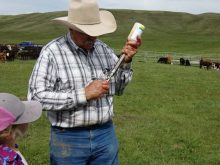A workshop sponsored by the Organization for Economic Co-operation and Development (OECD) and the Canadian Society of Microbiologists (CSM) on the application of plant-based immunotherapeutics and vaccines in veterinary medicine was held recently in London, Ont. The event was organized by Agriculture and Agri-Food Canada research scientists Rima Menassa and Ed Topp and was attended by over 40 experts from nine countries, representing research, regulatory, and commercial communities.
The key to the success of a vaccine is in its formulation and delivery. Traditionally, most cattle vaccines have been administered by injection, either intramuscularly or subcutaneously. The animals need to be confined and the vaccination often needs to be repeated. Needles raise the possibility of contamination and other safety issues including their disposal. Also, the costs of some vaccines are high.
Read Also

Alberta ranch family outlasts droughts
Over the years, the Lehr family has learned a thing or two about managing the ranch through dry years
Beyond all that, systemic vaccination is somewhat ineffective at eliciting protective immunity in the gut.
Combined, these factors have been viewed as impediments to the increased use of vaccines by the cattle industry. For example, Econiche, a vaccine that reduces the shedding of 0157:H7 by cattle, has achieved less than a five per cent market penetration in Canada. Partly it may be the cost, at $3 per dose, and partly the inconvenience of having to give multiple injections.
Scientists and producers have long thought there must be a better way of protecting the herd. Since over 90 per cent of pathogens enter and initiate infection at mucosal surfaces such as the gut, the best target for an effective vaccine for these pathogens may be the mucosal surface itself since it would reduce a pathogen’s ability to become established and replicate. It would be most desirable if a vaccine could elicit a mucosal immune response through contact with either the respiratory tract, GI tract or rectum. Getting a vaccine to these tissues is the challenge.
Nasal spray is one method. It is not a new process. Around 1000 AD the son of a Chinese statesman is said to have been inoculated against smallpox, probably by having powder from pulverized smallpox scabs blown into his nostril. Currently, nasal sprays are available for diseases such as IBR and PI3 in cattle.
The oral route is another way of targeting the mucosal layers of the gut. However, oral vaccines must avoid acidic and enzymatic denaturation before they reach the target tissue, and it is desirable that they be readily taken up by intestinal epithelium.
Vaccine effectiveness also depends on the formulation of the adjuvants and carriers that enhance and modulate the immune response to the antigen and deliver the vaccine to specific areas or facilitate uptake by the mucosal tissues.
Vaccine production costs are traditionally high, because you must produce, extract, purify, store, and transport the product. Until
25 years ago, vaccines were made largely of whole live or attenuated pathogens, usually cultured in host animals or cell cultures.
With advances in biotechnology, the production of subunit vaccines became feasible and expanded the range of target diseases. Instead of propagating whole pathogens, genes that encode single antigens can now be expressed in various host organisms. These subunit vaccines provoke specific immune responses, while eliminating the possible risk of infection associated with the use of attenuated intact pathogens.
VACCINES FROM PLANTS
Molecular farming using plants is an inexpensive and efficacious way to produce subunit vaccines for bacterial or viral pathogens. The plant can be directed to produce these proteins in its seeds, the leaves or even the chloroplasts (organelles responsible for capturing energy for the plant from the sun). In one study, expression of a foreign lytic protein in chloroplasts resulted in more than 70 per cent of the total soluble protein in the plant consisting of a bacteriophage lysine, the expressed target protein. In another, safflower seeds produced seven grams of recombinant subunit protein per kilogram of seed.
Plants expressing certain recombinant proteins could be used to produce and, possibly, deliver edible oral vaccines. Plants provide advantages over microbes and mammalian cells because they are highly scalable, inexpensive to grow, and do not produce endotoxins or support the replication of human viruses. Thus they are generally regarded as “safe.” The plant biomass can also function as a shelter-vehicle to deliver the vaccine by delaying degradation in the gut. Other plant components may also act as adjuvants, as many adjuvants in existing vaccines are of plant origin.
The initial work in plastid transformation used green algae. In higher plant species, tobacco, tomato, alfalfa and lettuce have been used successfully to produce biopharmaceuticals.
From the Alberta Farmer Express: Fall vaccinations and processing
Other research is using storage organelles to accumulate and encapsulate recombinant proteins. Seeds are naturally adapted for the storage of proteins in a stable and accessible form. Recombinant proteins expressed in mature seeds do not lose activity even when stored for several years. In addition, seeds are small so the protein is concentrated and easy to process. So far recombinant proteins have been produced in barley, maize, pea, safflower, soybean, and wheat seeds.
However, even though molecular farming of plants promises high yields of vaccine proteins, there are still challenges with administration. The antigen still needs to be stable and resistant to degradation in the digestive system. There must be an assured immune response to the target protein, which can be hampered by other non-target proteins in plants that may also elicit an immune response. Furthermore, genetically modified plants are subjected to rigorous regulatory oversight.
Turning these plants into feed presents other problems. It cannot be made into silage as the protein is broken down during ensiling. It can’t be stored wet because of spoilage. To feed it fresh it must be harvested daily. Drying, steam rolling, pelleting or extrusion may affect the structure and thus the immunogenic properties of the target protein.
These are the challenges facing AAFC researchers as they attempt to develop plant-based vaccines against bacterial diseases, including zoonotic diseases such as E. coli 0157:H7 and related VTEC.
At Lethbridge, Drs. McAllister, Stanford and Selinger have collected standard E. coli 0157 and E. coli 0157:H7 super-shedder isolates and are using whole genome comparative analyses to try to identify suitable antigen targets. These targets will make ideal protein candidates for plant-based vaccines that are specific against the E. coli 0157 responsible for the super-shedding phenomenon.
At AAFC London, Dr. Menassa, a plant transformation specialist, and her team have already developed several approaches for high-level expression of recombinant proteins. They will take the antigenic proteins provided by the Lethbridge group, as well as other proteins, clone them, and test their expression in tobacco. These plant-expressed proteins will then be purified and tested for immunogenicity and protective effects on model animal species.
The long-term goal is to produce low-cost plant-based vaccines that are as easy to administer as putting out some feed. Although it will take some time before we reach that point, all the pieces that we need to make this happen already exist.
As society becomes more comfortable with GM feeds, the creation of transgenic plants with specific health-promoting properties becomes a very real possibility.
Ursula Hiratsuka is a freelance technical and scientific writer, with a background in medicine and biological sciences. For further information contact Tim McAllister: [email protected].
















